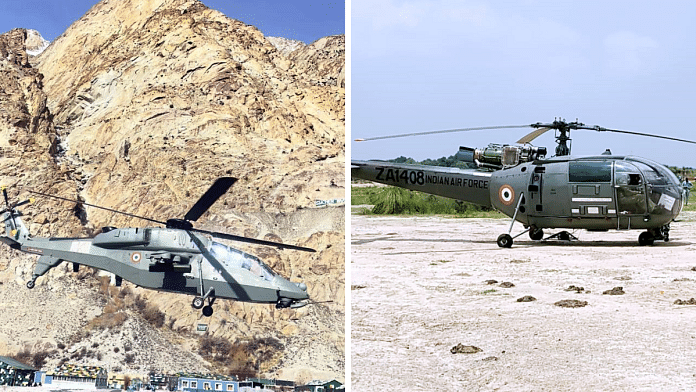New Delhi: The Army and the Air Force are moving to fast-track the purchase of 200 light reconnaissance and surveillance helicopters (RSH) to replace their ageing Cheetah and Chetak fleets.
According to the Request for Information (RFI) issued Friday by the Ministry of Defence (MoD), 120 helicopters are earmarked for the Army Aviation Corps and 80 for the Air Force.
The MoD describes the requirement as “urgent,” with the current fleet, based on 1960s-era French Aérospatiale designs, having flown well beyond its intended service life, often in some of the world’s most challenging environments.
Designed for multi-role operations in both day and night conditions, the reconnaissance and surveillance helicopters will be tasked with missions ranging from reconnaissance and surveillance to transporting small troop detachments or quick reaction teams for specialised operations. The helicopter will also carry internal and underslung loads (carried beneath the aircraft, typically attached with cables or slings) in support of ground forces, conducting armed scouting in coordination with attack helicopters and carrying out casualty evacuation.
The Indian Air Force inducted the Chetak helicopter in 1965, followed by the Cheetah in 1976. Together, across all three services, their combined fleet still numbers around 400.
However, these aging single-engine helicopters have increasingly shown the limits of their vintage design. In recent years, a series of serious accidents involving the Chetak and Cheetah have claimed the lives of several military personnel, underscoring the urgent need to modernise India’s light helicopter fleet.
Notably, the RFI for the new planned acquition emphasises transfer of technology (ToT) in line with the Defence Acquisition Procedure 2020. While not framed as a strict eligibility criterion, the government “is desirous of manufacturing helicopters in India after acquiring ToT,” as stated in the document.
This provision will allow foreign original equipment manufacturers (OEMs) to participate, provided they partner with an eligible Indian company through joint ventures or production arrangements and commit to sharing specified critical technologies, production know-how and support capabilities.
The selected suppliers will be obligated to provide lifetime support for the helicopters, including spares, maintenance tools, and equipment for both field- and component-level repairs. A vendor interaction is scheduled for later this month, with responses due by mid-October.
The current acquisition push follows earlier efforts to replace the Chetak and Cheetah fleets through the planned acquisition of 200 Kamov Ka-226T light utility helicopters from Russia, with 60 to be purchased in fly-away conditions and 140 to be assembled in India via a joint venture between Hindustan Aeronautics Limited (HAL) and Russian Helicopters under the Make in India program.
Under this arrangement, the HAL was to meet at least half the requirement, with the remainder to be built by the Indo-Russian Helicopters Ltd (IRGL), a joint venture of HAL, Russian Helicopters, and Rosoboronexport.
Signed in 2015 as the Modi government’s first government-to-government defense deal, the program remained in limbo over disagreements on indigenous content (Russia offered 62 percent against India’s stipulated 70 percent) and unresolved issues on technology transfer and cost.
Parallel to this, the HAL also developed its own Light Utility Helicopter (LUH). The platform, which received Initial Operational Clearance in 2020, has entered limited-series production (LSP) for eventual induction into both services, with 12 units—six each for the Army and the Air Force—currently on order.
The three-tonne helicopter has a service ceiling of 21,325 feet, a range of 500 km on internal fuel, and a top speed of 235 km/h. With a maximum take-off weight of 3,150 kg, it seats two crew members and is equipped with a Smart Cockpit Display System (glass cockpit), a health and usage monitoring system, and provisions for both utility and armed configurations.
While the earliest Chetak and Cheetah batches are no longer in service, most of the 186 Chetaks and over 200 Cheetahs still flying fall into the vintage category, having served for more than four decades.
(Edited by Ajeet Tiwari)
Also Read: Defence Secretary spells out big procurement push, overhaul of system






